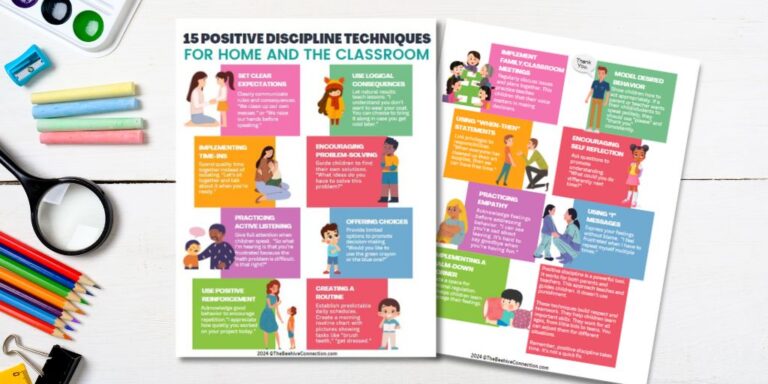Age Appropriate Discipline Chart PDF – The Positive Discipline Method
Disclosure: This post may contain affiliate links, meaning I may get a small commission if you decide to make a purchase through my links, at no cost to you.
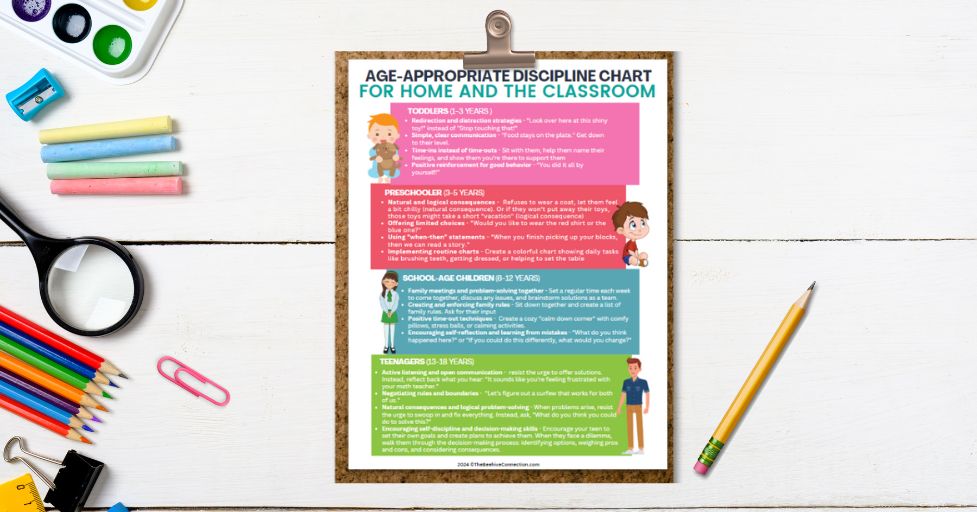
Introducing the Age Appropriate Discipline Chart PDF – The Positive Discipline Method
Parenting in 2024 is no walk in the park! But guess what? You’re not alone in this wild ride. Did you know that 81% of parents struggle with consistent discipline techniques? That’s where our age-appropriate discipline chart PDF comes in handy. We’ve got your back with a free PDF that’ll transform your parenting game.
We love parenting with positive discipline and use positive parenting ways to discipline that have been found to help children feel loved, wanted, and needed. Ready to dive into a world of gentle, effective discipline that grows with your child? Let’s go!
Please also check out our Positive Parenting Techniques PDF
What is Positive Discipline?

Let’s dive into the world of positive discipline – it’s not just a fancy parenting term, it’s a game-changer! As a parent myself, I’ve been asked how should parents discipline a child and this parenting guide to positive discipline can transform family dynamics.
But don’t just take my word for it; a study by the American Psychological Association found that positive discipline techniques lead to better long-term behavioral outcomes in children. Now that’s something to get excited about!
Definition and Core Principles of Positive Discipline
At its heart, positive discipline is all about teaching and guiding children with love and respect. It’s not permissive parenting – far from it! Instead, it’s about setting clear boundaries while maintaining a warm, supportive relationship with your child. The core principles include mutual respect, understanding the child’s perspective, effective communication, and focusing on solutions rather than punishment.
It’s about asking, “What can my child learn from this situation?” instead of “How can I make my child pay for their mistake?” Whether you want to discipline 7 year olds, or you ask how to discipline your 18 month old, with positive discipline techniques you can be sure that you’re on the right track.
Related:
Benefits of Using Positive Discipline Techniques
Oh, where do I start with the benefits? They’re like a gift that keeps on giving! First off, positive discipline helps build a stronger, more trusting relationship between you and your little one. It also promotes self-discipline, responsibility, and problem-solving skills.
Kids who experience positive discipline tend to have higher self-esteem and better emotional regulation. And here’s the kicker – these benefits often extend well into adulthood, setting your child up for success in future relationships and careers. Who wouldn’t want that for their kiddo?
Comparison with Traditional Punitive Methods
Now, I know what you might be thinking. “But what about good old-fashioned discipline? It worked for me!” Well, let’s break it down. Traditional punitive methods, like spanking or harsh punishments, might seem effective in the short term. But they’re like putting a band-aid on a broken arm – they don’t address the root cause of the behavior.
Positive discipline, on the other hand, is like teaching your child to fish. It equips them with the tools to make better choices in the future, rather than just fearing punishment. Plus, it avoids the negative side effects of punitive discipline, like increased aggression, resentment, and damaged self-esteem.
How Positive Discipline Fosters Emotional Intelligence
Here’s where things get really exciting! Positive discipline is like a secret weapon for boosting your child’s emotional intelligence. By using positive discipline techniques like active listening, empathy, and problem-solving together, you’re essentially giving your child a masterclass in understanding and managing emotions.
You’re teaching them to recognize their feelings, express them appropriately, and consider others’ perspectives. This emotional toolkit is invaluable – it can lead to better relationships, improved academic performance, and even greater success in the workplace later in life. Talk about setting your child up for a bright future!
Remember, positive discipline isn’t about being a perfect parent – because let’s face it, none of us are! It’s about creating a respectful, loving environment where both you and your child can learn and grow together. So, are you ready to embark on this positive parenting journey? Trust me, your future self (and your kids) will thank you!
Related:
Positive Discipline Techniques PDF
The Importance of Age-Appropriate Discipline
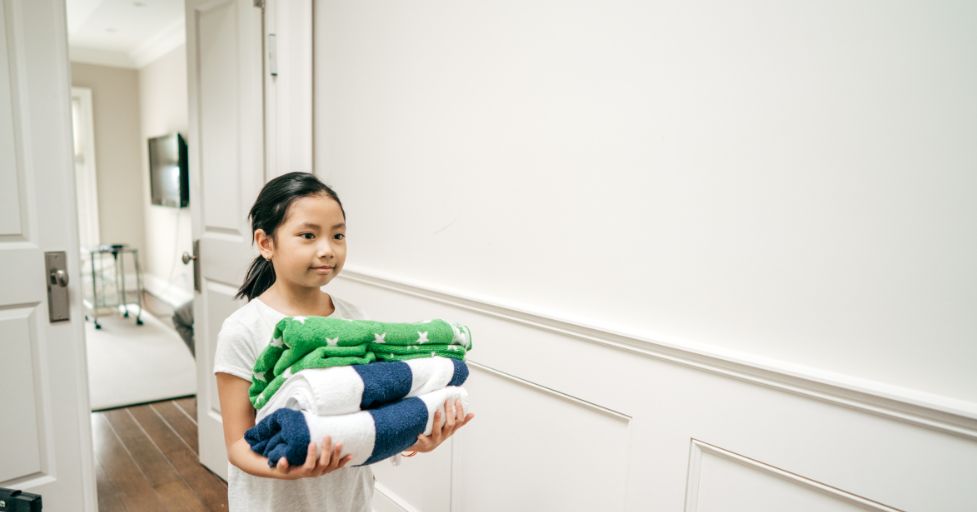
Let’s talk about why age-appropriate discipline is crucial. Did you know that according to a recent study, 62% of parents admit to using disciplinary methods that aren’t suited to their child’s developmental stage? Yikes! That’s like trying to teach a fish to climb a tree – it’s just not going to work, folks!
Why One-Size-Fits-All Discipline Doesn’t Work
Think about it – would you use the same approach to explain something to a toddler and a teenager? Of course not! The same goes for discipline. Each child is unique, and what works for one might be a total flop for another. One-size-fits-all discipline ignores the fact that children have different temperaments, learning styles, and emotional needs. It’s like trying to fit a square peg in a round hole – frustrating for everyone involved!
Developmental Stages and Their Impact on Discipline
Here’s where it gets really interesting! As children grow, their brains develop in fascinating ways. A toddler’s brain is like a sponge, soaking up everything around them, while a teenager’s brain is rewiring itself faster than you can say “mood swing.”
Understanding these stages is key to effective discipline. For example, a 2-year-old’s tantrum isn’t defiance – it’s often frustration at not being able to express complex emotions. Knowing this can completely change how we respond!
Long-Term Benefits of Tailored Disciplinary Approaches
When we tailor our discipline to our child’s age and stage, we’re not just solving immediate behavior issues – we’re investing in their future! Age-appropriate discipline helps children develop self-regulation, empathy, and problem-solving skills.
It’s like we’re giving them a toolbox for life, filled with strategies to handle challenges and emotions. And let me tell you, as a parent who’s been through the trenches, seeing your child use these skills independently is incredibly rewarding!
Building Stronger Parent-Child Relationships Through Understanding
Here’s the real magic of age-appropriate discipline – it strengthens your bond with your child. When we take the time to understand our child’s developmental needs, we’re showing them that we see them, we hear them, and we respect them.
This creates a foundation of trust and open communication that can weather any storm. And trust me, when you hit those turbulent teenage years, you’ll be grateful for that strong foundation!
Toddlers (1-3 years): Gentle Guidance Techniques

Ah, toddlers – those adorable little tornados of energy and emotion! Did you know that toddlers hear the word “no” up to 400 times a day? That’s a lot of negativity for such little people! Let’s explore some gentler, more effective ways to guide our littlest learners.
Redirection and Distraction Strategies
Redirection is your secret weapon in the toddler years. It’s like being a magician – “Look over here at this shiny toy!” instead of “Stop touching that!”
I’ve used this countless times with my kids, preschool students, and special needs young adults, and let me tell you, it works like a charm. The key is to be quick and enthusiastic. Your energy can turn a potential meltdown into a fun new activity!
Simple, Clear Communication Tips
When it comes to toddlers, less is more. Their little brains are processing so much information, so keep your instructions short and sweet. Instead of a long explanation about why they shouldn’t throw food, try a simple “Food stays on the plate.”
And here’s a pro tip – get down to their eye level when you’re talking. It’s amazing how much more they listen when you’re not towering over them!
Time-Ins vs. Time-Outs
Forget what you’ve heard about time-outs – time-ins are where it’s at for toddlers! Instead of isolating your child when they’re struggling, bring them close. It’s like being their emotional coach.
With Time ins you sit with them, help them name their feelings, and show them you’re there to support them. It might feel counterintuitive at first, but trust me, it’s incredibly effective in helping toddlers learn to regulate their emotions.
Related:
The Ultimate Guide to Time Ins
Positive Reinforcement for Good Behavior
Catch them being good! It’s so easy to focus on correcting negative behavior, but celebrating the positive can work wonders. Positive Reinforcement is about making a big deal out of it when your toddler shares a toy or uses gentle hands.
Your enthusiasm is like fuel for their good behavior engine. And don’t forget the power of non-verbal reinforcement – a high five, a hug, or a big smile can speak volumes to a toddler!
Related:
Words of Encouragement Vs. Praise
Positive Reinforcement Parenting
Remember, the toddler years are challenging, but they’re also filled with wonder and rapid growth. By using these gentle guidance techniques, you’re not just managing behavior – you’re nurturing a confident, emotionally intelligent little human. And that, my friends, is worth all the spilled milk and crayon-covered walls in the world!
Check out our Positive ParentingTechniques PDF
Preschoolers (3-5 years): Encouraging Cooperation

Welcome to the wonderful world of preschoolers! Did you know that the average preschooler asks about 300 questions a day? That’s right, these little ones are curious, energetic, and sometimes… a bit challenging. But fear not! I’ve got some fantastic strategies to help you navigate this exciting stage and encourage cooperation.
Natural and Logical Consequences
Let’s talk about consequences, but not the scary kind! Natural and logical consequences are like little life lessons wrapped up in everyday experiences. For instance, if your preschooler refuses to wear a coat, let them feel a bit chilly (natural consequence). Or if they won’t put away their toys, those toys might take a short “vacation” (logical consequence).
It’s all about helping them connect their choices with outcomes. Trust me, it’s much more effective than lectures or punishments!
Offering Limited Choices
Preschoolers love to feel in control, and offering choices is a great way to give them that feeling while still maintaining boundaries. The key word here is “limited.” Instead of asking, “What do you want to wear?”
Try “Would you like to wear the red shirt or the blue one?” This simple technique can turn potential power struggles into smooth sailing. I’ve used this countless times with my own kids, and it’s like magic!
Using “When-Then” Statements Effectively
“When-then” statements are your new best friend. They’re a positive way to set expectations and motivate your preschooler. For example, “When you finish picking up your blocks, then we can read a story.”
It’s not a bribe; it’s a clear, cause-and-effect statement that encourages cooperation. Plus, it sounds so much better than “If you don’t clean up, no story!” Positive language for the win!
Implementing Routine Charts for Structure
Preschoolers thrive on routine, and a visual chart can be a game-changer. Create a colorful chart showing daily tasks like brushing teeth, getting dressed, or helping to set the table. Make it fun!
Use stickers or drawings, and let your child participate in creating it. Not only does this provide structure, but it also boosts their sense of accomplishment. Who doesn’t love checking off a completed task?
School-Age Children (6-12 years): Fostering Responsibility

Ah, the school-age years! This is where things get really exciting. Your child is growing more independent every day, and it’s the perfect time to start fostering real responsibility.
Here’s a fun fact: children who are given age-appropriate responsibilities are more likely to have higher self-esteem and better academic performance. Let’s dive into how we can make this happen!
Family Meetings and Problem-Solving Together
Family meetings might sound formal, but they’re actually a fantastic way to bond and teach problem-solving skills. Set a regular time each week to come together, discuss any issues, and brainstorm solutions as a team.
I remember when we started family meetings at home – at first, the kids were skeptical, but soon they looked forward to having a voice in family decisions. It’s amazing to see even young children come up with creative solutions when given the chance!
Related:
How to Have a Successful Family Meeting
Creating and Enforcing Family Rules
Here’s where you can really involve your school-age children in the process of setting boundaries. Sit down together and create a list of family rules. Ask for their input – you might be surprised at how fair and thoughtful they can be!
Once the rules are set, be consistent in enforcing them. Remember, the goal isn’t to be the “bad guy,” but to create a safe, respectful environment for everyone. And don’t forget to follow the rules yourself – monkey see, monkey do!
Positive Time-Out Techniques
Forget what you know about traditional time-outs. Positive time-outs are all about helping your child regain control and learn from the situation. Create a cozy “calm down corner” with comfy pillows, stress balls, or calming activities.
Teach your child to recognize when they need a break and encourage them to use this space proactively. It’s not a punishment, it’s a valuable life skill! I’ve seen kids go from meltdown to problem-solving mode after just a few minutes in their calm-down space.
Remember, fostering responsibility in these years is setting the stage for a confident, capable teenager and adult. It might take more effort now, but trust me, it’s an investment that pays off big time in the future!
Encouraging Self-Reflection and Learning from Mistakes

Let’s talk about one of the most powerful tools in our parenting toolkit: teaching our kids to learn from their mistakes. Now, I know what you’re thinking. “But how do I get my stubborn 9-year-old to actually reflect on anything?” Well, I’ve been there, and I’ve got some tricks up my sleeve that I’m excited to share with you!
First things first, let’s ditch the shame game. When your child makes a mistake, resist the urge to lecture or punish. Instead, take a deep breath (trust me, you’ll need it) and approach the situation with curiosity.
Ask open-ended questions like, “What do you think happened here?” or “If you could do this differently, what would you change?” These questions spark self-reflection without putting your child on the defensive.
But here’s the real kicker – make sure you share your own mistakes and reflections too! Nothing normalizes error quite like seeing Mom or Dad say, “Oops, I messed up. Here’s what I learned.” It shows your kids that mistakes are a normal part of life and that the real magic is in how we grow from them.
Celebrate Wins in Self Reflection
Remember, the goal isn’t perfection – it’s progress. Celebrate the small wins when your child shows self-awareness or comes up with a solution on their own. A simple “I’m proud of how you thought that through” can work wonders for their confidence and motivation.
And here’s a pro tip: use bedtime as a reflection opportunity. Ask your child to share one thing they learned that day, even if it came from a mistake. It’s a beautiful way to end the day on a positive, growth-oriented note.
By encouraging self-reflection and framing mistakes as learning opportunities, we’re not just solving immediate problems – we’re equipping our kids with invaluable life skills. We’re raising resilient, thoughtful individuals who aren’t afraid to take risks and learn from the outcomes.
So, the next time your child spills milk all over the kitchen floor or forgets their homework, take a deep breath and remember – this isn’t just a mess or a mishap, it’s a chance to foster responsibility and critical thinking. And who knows? You might just learn something new yourself in the process!
Teenagers (13-18 years): Promoting Independence

Buckle up, parents! We’re entering the teenage years, and it’s going to be quite a ride. Did you know that the teenage brain undergoes a massive rewiring process, second only to the growth spurt in infancy? It’s like their brains are getting a complete overhaul, and our job is to guide them through this wild renovation!
Active Listening and Open Communication
First things first: put down your phone, turn off the TV, and really listen to your teen. I mean, really listen. Active listening is your superpower in these years. When your teen feels heard, they’re more likely to open up.
Try this: next time your teen starts talking, resist the urge to offer solutions. Instead, reflect back what you hear: “It sounds like you’re feeling frustrated with your math teacher.” You’ll be amazed at how this simple technique can deepen your conversations!
Negotiating Rules and Boundaries
Remember when you could just say “because I said so”? Those days are long gone! Teens need to feel a sense of control, so involve them in setting rules and boundaries.
Start with: “Let’s figure out a curfew that works for both of us.” This approach teaches valuable negotiation skills and shows respect for their growing maturity. Plus, they’re more likely to follow rules they helped create. It’s a win-win!
Natural Consequences and Logical Problem-Solving

Here’s where we step back and let life do some of the teaching. If your teen forgets their lunch, don’t rush to school to drop it off. A hungry afternoon might just be the reminder they need to be more prepared tomorrow.
When problems arise, resist the urge to swoop in and fix everything. Instead, ask, “What do you think you could do to solve this?” You’re not being mean; you’re being a coach, helping them develop critical thinking skills they’ll need for life!
Encouraging Self-Discipline and Decision-Making Skills
This is the grand finale of our parenting symphony – helping our teens become self-reliant adults. Encourage your teen to set their own goals and create plans to achieve them.
When they face a dilemma, walk them through the decision-making process: identifying options, weighing pros and cons, and considering consequences. It’s like teaching them to fish instead of handing them a fish stick. They might make some mistakes along the way, but that’s all part of the learning process!
How to Use Our Age Appropriate Discipline Chart PDF

Now that we’ve covered the stages, let’s talk about putting this knowledge into action with our handy-dandy Age Appropriate Discipline Chart PDF. Think of it as your parenting GPS – always there to guide you when you feel lost!
Downloading and Printing Instructions
Getting your hands on this chart is as easy as pie! Just click the download button at the bottom of this page, and voila! You’ll have your very own parenting cheat sheet. For best results, print it in color (if you can) and on sturdy paper. You might want to laminate it too – trust me, it’ll see a lot of use!
Download the Age Appropriate Discipline Chart PDF Here
Implementing the Chart Consistently
Consistency is key, folks! Hang your chart somewhere visible – the fridge, the family command center, wherever you’ll see it daily. Reference it often, especially when you’re unsure how to handle a situation.
But remember, it’s a guide, not a rulebook set in stone. Use your parental intuition along with the chart for best results.
Adjusting Strategies as Your Child Grows
Just like your kids, this chart should grow with your family. Set a reminder to review and update it every 6 months or so.
As your children mature, their needs and capabilities will change, and your discipline strategies should evolve too. It’s like updating the software on your phone – necessary for optimal performance!
Remember, positive discipline isn’t about being a perfect parent (newsflash: there’s no such thing!). It’s about creating a respectful, loving environment where both you and your children can learn and grow together.
So, are you ready to embark on this positive parenting journey? Download our chart, take a deep breath, and let’s raise some amazing humans together!
Common Challenges and Solutions in Positive Discipline
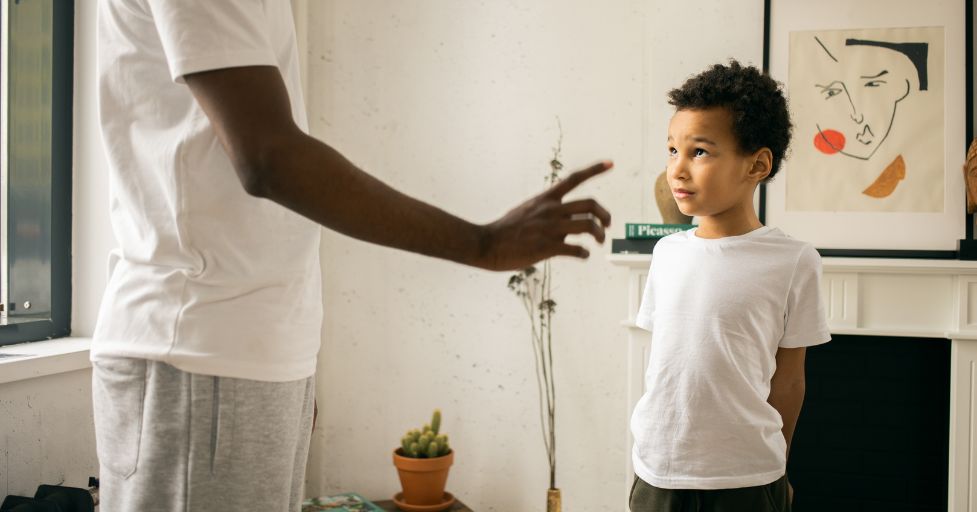
Let’s face it, parenting isn’t always sunshine and rainbows. Even with the best intentions and positive discipline techniques, we’re bound to hit some bumps in the road. But don’t worry, I’ve got your back!
Did you know that 85% of parents report feeling overwhelmed at least once a week? You’re not alone in this, and together, we’re going to tackle some of the most common parenting challenges head-on!
Dealing with Tantrums and Meltdowns
Ah, tantrums – the Mount Everest of parenting challenges! First things first, take a deep breath. Remember, your child isn’t giving you a hard time; they’re having a hard time. When a meltdown hits, stay calm (easier said than done, I know!).
Get down to your child’s level and acknowledge their feelings: “I can see you’re really upset right now.” Sometimes, a simple hug can work wonders. For older kids, teach them to use a “calm down corner” where they can go to regulate their emotions.
And here’s a pro tip: prevent tantrums by keeping your child well-rested and fed. A hangry child is a ticking time bomb!
Related:
Tips for Taming Tantrums from Toddlers to Teens
Sibling Rivalry and Conflict Resolution

If you’ve got more than one kid, you’ve probably witnessed more fights than a boxing referee! But here’s the silver lining: sibling conflicts are actually opportunities to teach valuable life skills.
Instead of playing judge and jury, try this: set up a “peace table” where siblings can work out their differences. Teach them to use “I feel” statements and to listen to each other’s perspectives.
And remember, it’s okay to let them resolve minor squabbles on their own. They’re building problem-solving muscles!
Screen Time Battles and Setting Limits
In today’s digital age, screen time battles are as common as spilled milk. The key is to set clear, consistent boundaries from the get-go. Create a family media plan together, involving your kids in the process.
Use tech to your advantage – there are great apps out there that can help manage screen time. But here’s the real secret: be a good role model. If you’re constantly glued to your phone, your kids will follow suit. How about declaring “screen-free” times for the whole family? Board games, anyone?
Related:
Check Out and Download Our Screen-Time Bingo Cards
Handling Disrespect and Backtalk Positively
Ouch! Nothing stings quite like disrespect from your own child. But before you react, remember this: disrespect often comes from a place of frustration or a need to assert independence. Take a moment to cool down (count to ten, do some deep breathing, whatever works for you).
Then, address the behavior, not the child. “I feel disrespected when you speak to me that way” is much more effective than “You’re so disrespectful!”
Teach alternative ways to express frustration, like “I feel angry when…” And here’s a game-changer: regularly have one-on-one time with each child. When their emotional tanks are full, they’re less likely to act out.
Remember, these challenges are all part of the parenting journey. They’re not signs of failure; they’re opportunities for growth – for both you and your child. Positive discipline isn’t about perfection; it’s about progress.
So the next time you’re faced with a screaming toddler in the grocery store or teenagers arguing over the last cookie, take a deep breath and remind yourself: “I’ve got this. We’re learning together.”
And hey, on those days when you feel like you’re barely keeping your head above water? That’s okay too. Pour yourself a cup of coffee (or wine, I won’t judge), call a friend, and remember that tomorrow is a new day. You’re doing great, parent! Keep up the awesome work!
Related:
Tips for Taming Tantrums from Toddlers to Teens
Powerful Alternatives to Yelling
Conclusion for Age Appropriate Discipline Chart PDF:
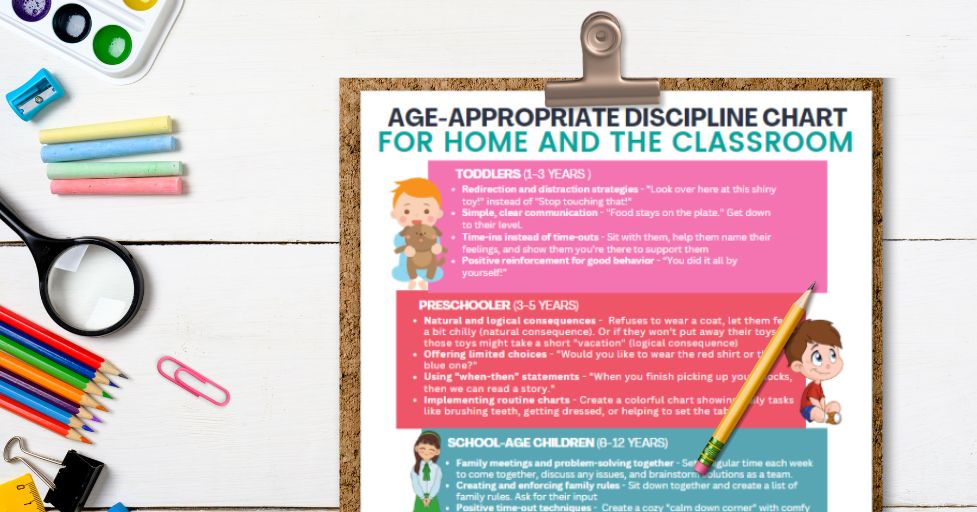
Whew! We’ve covered a lot of ground, haven’t we? Remember, positive discipline isn’t about being perfect – it’s about progress. By using our age-appropriate discipline chart, you’re taking a huge step towards creating a loving, respectful relationship with your kids.
Download our free PDF today and start your journey towards more peaceful parenting. You’ve got this, and we’re here to support you every step of the way. Ready to transform your family dynamics? Let’s make 2024 the year of positive change!
FAQ for Age Appropriate Discipline Chart PDF

Q1: What is positive discipline?
A: Positive discipline is a loving approach to teaching kids good behavior. It focuses on respect, understanding, and teaching life skills instead of punishment. The goal is to help children learn from their mistakes and make better choices in the future.
Q2: How do I use an age appropriate discipline chart?
A: Start by downloading and printing the Age Appropriate Discipline Chart PDF. Hang it where everyone can see it. Use it as a guide for handling different situations with your kids. Remember to adjust your approach as your children grow and their needs change.
Q3: What are some positive discipline techniques for toddlers?
A: For toddlers, try redirection (changing their focus to something else), using simple words to explain rules, and praising good behavior. Time-ins (staying close to comfort them) work better than time-outs. Remember, consistency and patience are key!
Check out Our Positive Discipline Techniques PDF Here
Q4: How can I handle teen backtalk positively?
A: Stay calm and listen to understand their perspective. Set clear expectations for respectful communication. Teach them better ways to express frustration, like “I feel…” statements. Remember, teens are learning to be independent, so involve them in making family rules.
Q5: Why is age-appropriate discipline important?
A: Age-appropriate discipline works better because it matches your child’s understanding and abilities. It helps kids learn and grow at their own pace. Using the right approach for each age builds stronger parent-child relationships and teaches important life skills.
Q6: What can I do about fathers who don’t discipline?
A: First, have a calm talk with your co-parent about the importance of consistent rules. Share information on positive discipline and its benefits. Try to agree on some basic rules you both enforce.
If he’s unsure how to discipline, practice together or suggest parenting classes. Remember, patience and teamwork are key. If issues persist, consider family counseling for additional support.
GET FREE ACCESS TO OUR LIBRARY OF FREE PRINTABLES AND RESOURCES!
Enter Your Name and Email for FREE Access to our Library of FREE Home and Family Printables Series!

